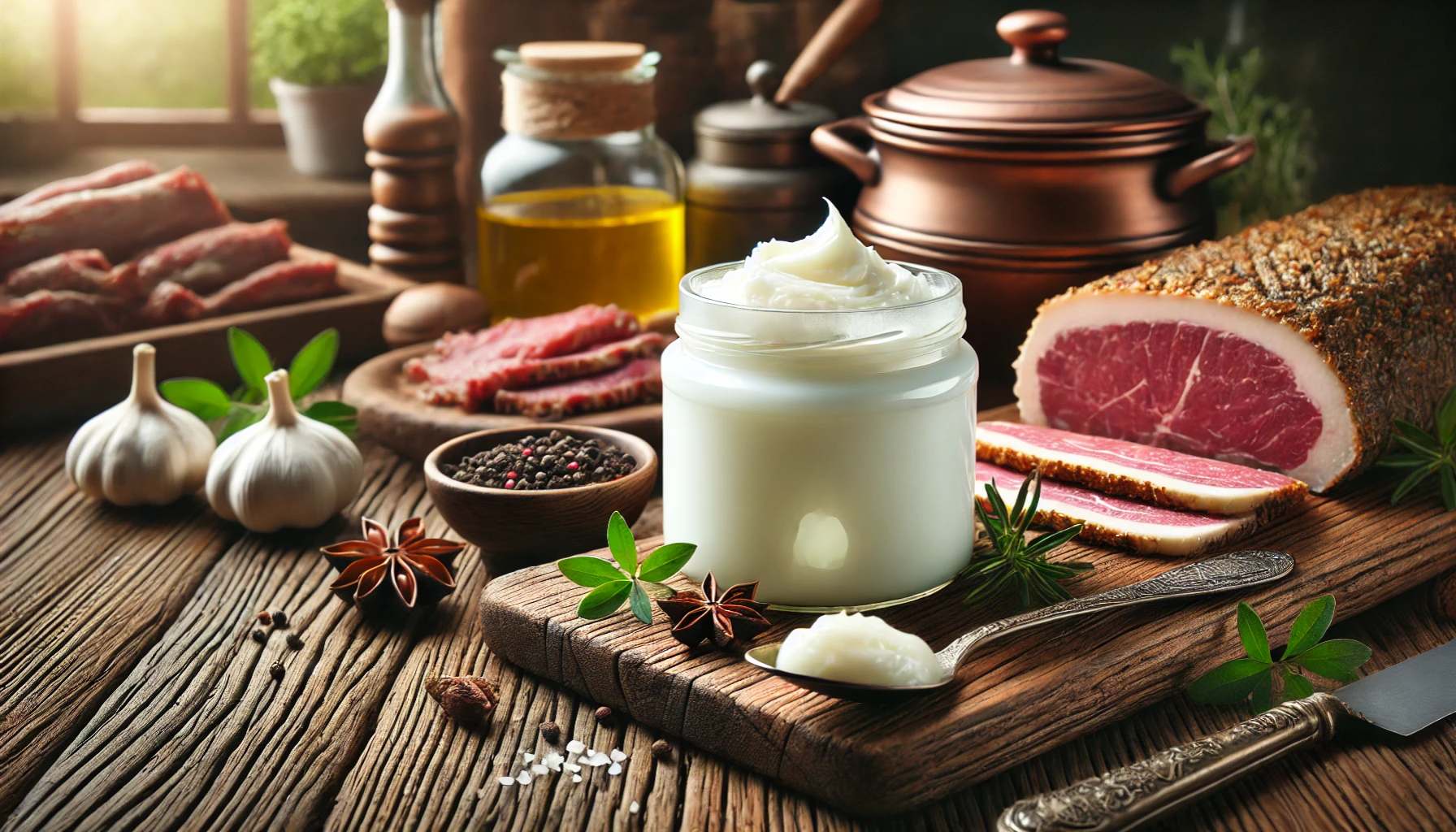What Is Beef Tallow? Discover Its Benefits and Uses

People are starting to notice beef tallow, and it’s making a name for itself as a natural, nutrient-dense fat to include in your diet or skincare routine.
This cooking fat is more than that—a healthy, sustainable option that is starting to be rediscovered as beneficial.
This guide will teach you everything you need to know about beef tallow, how it is made, and why it might be an excellent addition to your lifestyle.
What Is Beef Tallow?
The fat from beef is usually from the fatty tissue surrounding the kidneys or other parts of the animal.
The melted fat is strained to remove impurities, which leaves pure, clean tallow.
This fat has been used in cooking, skincare, and even as a candle for centuries.
It’s making a comeback these days as a more healthy alternative to processed oils and as a moisturizing ingredient in natural skincare products.
How Is Beef Tallow Made?
The rendering of beef fat is a simple process.
You begin with raw beef fat, otherwise known as suet.
Chopped into small pieces or ground to help melt down more evenly, the fat helps out.
Then, you melt the fat over low heat and slowly heat it.
Water and impurities are removed as it melts, leaving the clear, liquid fat behind.
Once fully rendered, the fat is strained through a fine mesh or cheesecloth to remove any remaining solids.
The liquid cools and solidifies into fat that can be stored for long periods.
You can make homemade fat in your kitchen by rendering suet from a local butcher or purchasing pre-rendered beef fat from your store or online.

Is beef tallow healthy?
We know beef tallow is often misunderstood, but it’s actually a source of healthy fats that, when used in moderation, can benefit your body.
It’s high in saturated fats, which are stable at high temperatures and great for cooking. (1)
Beef tallow also contains natural compounds such as conjugated linoleic acid (CLA) and omega-3 fatty acids, which are thought to have anti-inflammatory properties. (2)
Healthy fats support brain function, hormone balance, and energy levels.
We’re not suggesting that you eat any fat, but beef tallow is a healthier option than processed vegetable oils, which are often high in omega-6 fatty acids and prone to oxidation when heated. (3)
Beef tallow is a great fat to add to your diet if you’re on a low-carb or ketogenic diet, as it is a natural source of energy without carbohydrates.
To further support your overall wellness, consider incorporating high-quality supplements that can enhance your daily health routine

Benefits of Beef Tallow
For Cooking
Its excellent cooking properties are one of the main reasons people turn to beef fat.
It has a smoke point of around 400°F (200°C) and is great for frying, sautéing, and roasting without breaking down the fat into harmful compounds we don't want.
Tallow adds rich flavor to food, especially in traditional dishes such as roasted vegetables, fried potatoes, or meats.
Tallow is unlike many modern vegetable oils in that it does not contain artificial trans fats that have been linked to many health issues.
For Skin Care
Beef fat isn’t just for cooking.
It’s also gaining popularity in natural skincare.
Tallow is similar to the oils naturally found in human skin, making it an excellent moisturizer. (4)
Vitamins A, D, E, and K are all good for skin health and are rich in them.
Tallow is great for people with sensitive or dry skin, as it helps with moisture and doesn’t irritate.
Even some use it as a soothing condition for things like eczema or psoriasis.
Sustainability
The sustainability of beef tallow is another benefit.
Using tallow is a great way to reduce waste since much of the animal would be thrown away.
When we care about the environment, which we do more and more, choosing tallow over highly processed oils is a more environmentally friendly option.
How is beef tallow used for cooking?
There are several cooking applications for beef tallow.
It is one of its most popular uses for frying.
Its high smoke point makes it perfect for deep frying, creating a crispy golden crust without breaking down like other oils. Because of its high smoke point, it’s very stable.
Don’t forget that tallow is also perfect for roasting vegetables because it adds a layer of rich flavor that oils like olive or canola can’t provide.
Many people also use it to sauté meats and vegetables and even add a spoonful to soups and stews for an extra hit of fat and flavor.
Beef tallows can also be baked in place of butter or shortening in pie crusts or biscuits to give them a flaky, tender texture.
What Can Beef Tallow Do in Skincare?
If you're looking for a natural, nontoxic moisturizer, beef tallow is a great option.
Unlike many commercial skin care products that contain synthetic chemicals, tallow is entirely natural and contains no additives.
It seals moisture in and helps your skin keep its natural oils.
It’s beneficial for people with dry or sensitive skin.
Tallow can be used directly on the skin or mixed with essential oils or other ingredients to create customized skincare products.
Some people even use it as a base for homemade lotions, balms, and lip products.
It is an excellent option for soothing skin irritation and redness because of its anti-inflammatory properties. (5)
Beef Tallow vs. Lard: What’s the Difference?
Beef tallow is not lard, and many people need clarification.
Rendered fat from pigs is called lard, and fat from cows or other ruminant animals, such as sheep, is called fat.
Both are used in the same way in cooking and skincare, but their flavors and fat compositions differ.
Lard has a slightly porky flavor, while pork is more neutral and may not be appropriate for all dishes.
Both fats are high in saturated fats and can be part of a healthy diet if eaten in moderation.
Though tallow is more subtle in its flavor and has a higher smoke point, which makes it more versatile for various cooking methods, some prefer it.
Beef Tallow Storage and Use
Beef tallow is extremely shelf-stable, especially if kept in an airtight container in a cool, dark place.
It will last at room temperature for a few months, but refrigerate or freeze for more extended storage.
When ready, just scoop out the amount you need and melt it while cooking.
Use for skincare by warming in your hands or over low heat before applying to your skin.
Tallow can be substituted for any other cooking fat if you’re using it for frying, roasting, or sautéing.
However, just make sure you only use it in recipes whose rich flavor will help bring out the other ingredients.
Final Thoughts
Beef tallow is a versatile natural fat with many benefits.
It’s a great alternative to processed oils and chemical-laden skincare products, whether adding flavor to your food or moisturizing your skin.
It’s nutrient-rich, sustainable, and easy to add daily.
Beef tallow is worth considering if you’re looking for a healthy fat that does more than add flavor to your food.
🥩 Cook and glow naturally! Try beef tallow for nutrient-rich meals and skincare benefits today. ✨
FAQs
What is beef tallow made of?
Rendered beef fat makes beef tallow, usually fat surrounding the kidneys.
How unhealthy is beef tallow?
If you consume beef tallow in moderation, it is not unhealthy and contains healthy fats such as omega-3s and CLA.
Is beef tallow just grease?
Beef tallow is not beef fat; it is a refined form of beef fat that has been rendered cleaning up to make it stable and clean for cooking or skin.
How do you make beef tallow?
To make beef tallow, you simply heat chopped beef fat slowly on low heat until it melts, straining it to remove solids.
Is it safe to use beef tallow on your skin?
Beef tallow is a great moisturizer for the skin and can soothe dryness, irritation, or inflammation.
Related Studies
Title: Tallow, Rendered Animal Fat, and Its Biocompatibility With Skin
This study demonstrates that emulsions containing mutton tallow can effectively improve skin hydration and provide symptomatic relief for conditions like atopic dermatitis.
Link: https://pmc.ncbi.nlm.nih.gov/articles/PMC11193910/
Title: The effects of conjugated linoleic acid supplementation on inflammatory cytokines and adipokines: A systematic review and meta-analysis
This meta-analysis reveals that CLA supplementation significantly reduces inflammatory markers such as IL-6 and TNF-α, suggesting its potential anti-inflammatory benefits.
Link: https://www.frontiersin.org/journals/immunology/articles/10.3389/fimmu.2023.1092077/full
Title: Influence of Heating during Cooking on Trans Fatty Acid Content of Edible Oils
The study concludes that heating edible oils to common cooking temperatures has minimal effects on trans fatty acid (TFA) generation, highlighting the stability of saturated fats compared to polyunsaturated fats.
Link: https://pmc.ncbi.nlm.nih.gov/articles/PMC9002916/
This research discusses the complex role of omega-6 fatty acids in inflammation, indicating that while they are precursors to pro-inflammatory mediators, their dietary intake may not necessarily increase inflammation.
Link: https://eprints.soton.ac.uk/418974/1/Omega_6_fatty_acids_and_inflammation_Final_Revised.pdf
Title: Effects of Repeated Heating on Fatty Acid Composition of Plant-Based Oils
This study finds that repeated heating of vegetable oils significantly decreases beneficial polyunsaturated fatty acids while increasing saturated fatty acids, emphasizing the health risks associated with high-temperature cooking.
Link: https://pmc.ncbi.nlm.nih.gov/articles/PMC8774349/
